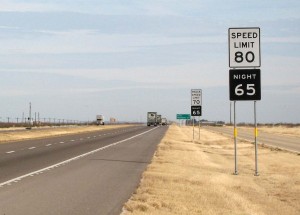The Texas Department of Transportation is getting to raise the speed limit on a stretch of toll road near Austin to 85 mph, which would be the fastest figure in the country and only about 1 mph below the limits set on a marked highway in Abu Dhabi.
Speed limits have generally been going up in recent years following a decision in Congress to allow states to decide what’s best, a far cry from the era when federal highway funds were tied to maintaining strict enforcement of the dread “double-nickel” 55 mph limit.
While most parts of the East have steadfastly held to 55 and even 50 on their generally crowded routes, states in the wild, wild West have eagerly been leapfrogging one another to see just how high they could go. Nevada nudged 75 cueing Texas lawmakers last year to approve even higher limits.
Much of the Lone Star State’s Highway 130 already are up to 80, but the law allows for 85 and Texas Department of Transportation engineers are set to conduct a formal study to see if that can be safely maintained on the stretch near Austin. But they’ve already signaled their likelihood to give the increase a green light.
Might they go even higher? Texans typically don’t like to be second to anyone but the 85 mph limit will leave them about 1 mph behind a patch of highway in Abu Dhabi and another in Poland that, when converted from the metric allow drivers to shoot along at 86.
For a brief while Montana top the charts in the U.S., like the German Autobahn setting no speed limit at all – just requiring motorists to use reasoned judgment. In practice, that usually meant you could get pulled over if you were doing in excess of 90 to 100. Under pressure from Washington, Montana set a formal limit of 75 for passenger cars.
In fact, 11 states now have 75 mph limits, including Kansas, Colorado and Arizona – though urban areas usually run slower.
On the other side of the speedometer, Delaware and New York are the slowest, at 55 – unless you count the territory of Guam, at a mere 40 mph.
Curiously, despite the contention of safety advocates who lamented that the highway death rate would surge once Congress freed the states to boost their speed limits quite the opposite has happened. In fact, according to preliminary data from the National Highway Traffic Safety Administration the latest figures are the lowest since 1949 and measured on a per-100-million-miles-driven basis are the lowest ever recorded.
Whether that will further encourage states like Texas remains to be seen, however. If anything, lawmakers now face the argument that faster driving burns more fuel . According to data posted on fueleconomy.gov, a vehicle is 3% less efficient at 60 mph than when running at 55. It is 17% less efficient at 70 and 28% less efficient at 80 mph.
That’s one of the reasons the German government has been steadily chipping away, with only about a third of the Autobahn now completely without speed limits.

